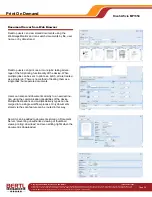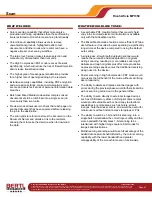
Copyright © 2006 MCA Internet, LLC dba BERTL.
13 November 2006
All Rights Reserved. The license under which this document is made available and applicable law prohibit any reproduction or further transmission of any portion of this document. This
document may only be viewed electronically through the www.BERTL.com Web site and may not be stored in electronic or hard copy format. Any reproduction of trademarks is strictly
prohibited. BERTL accepts no responsibility for any inaccuracies or omissions contained in this document.
Page 33
Ricoh Aficio MP1350
PCL6 Print Driver Functionality
The PCL6 driver has a familiar look and feel following
industry-standard layout and design. The Setup tab
provides the main print functionality. Job delivery options
include private and sample print modes plus an option to
send jobs to the Document Server for print on demand
purposes.
For those not needing multiple media supplies in a single
document, all major features are found on the opening
tab. This eliminates the need to navigate away from the
opening tab and reduces job build times. The MP1350
can only be equipped with the separate die punch GBC
unit. In the screenshot opposite.
For those looking for more media flexibility, the Paper tab
allows users to specify a media supply for the front, back,
and chapter/insert pages. This flexible feature set allows
a wide range of professional documents to be produced.
Chapter mode and user defined modes both allow users
to work on any given page within the document applying
media type, selection, and printing attributes (1 side, 2
side, no print, lead chapter page (such as starting on the
facing page). All media sources can be selected for each
paper selection type with the exception of user defined
mode, which does not provide access to the twin
interposer unit. This would have been a good feature to
enable since user defined mode allows for entire page
ranges to be added quickly versus chapter mode, which
does allow for feeding from the interposer units. Chapter
mode applies the setting on a page by page basis.
With little trial and error, users can build a very wide
range of documents incorporating up to nine different
media supplies that should more than adequately provide
for the toughest in-house printing needs.
Print Quality settings are fairly standard with users able
to choose 600 dpi or 1,200 dpi output, vector or raster
graphics, edge-to-edge printing, toner save mode, and
true type font mode.
















































